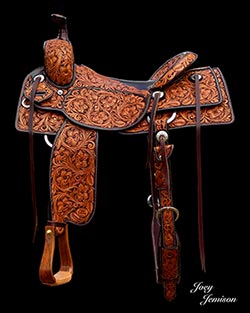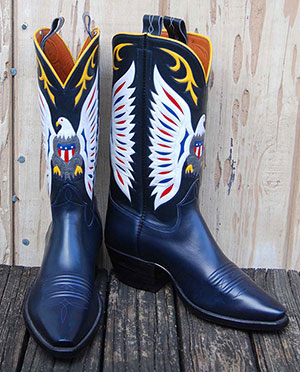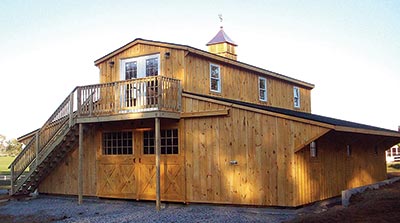Tack & Farm
Our Tack & Farm section features an Apparel section to find both practical and fashionable riding attire. If you ride English & Western or Race, many sources are available in the Tack section.
Building a barn? Need an architect for your equine dream home? Find one in Barns & Stalls.
Have a hungry horse? Of course you do! Find a place to buy your feed and tuck your horse in at night in the Bedding & Feed section. Looking for a place to keep your horse? You can find it in the Horse Boarding section. Keep your horse happy and beautiful with resources in our Grooming section.
Traveling? Find a Shipping company or Horse Sitting service if your horse is staying home!
Running and maintaining a farm or stable is a continuous effort, and to help find products or tools you need, please see our Equipment, Fencing and Management Tools sections.
Seeking Services? Find financial and tax expertise in our Accounting section. Companies who will help protect your investment are found in the Insurance section. For those who want legal advice about purchasing, liability, and other issues, please look at the Equine Law section to find an expert. Build and promote your business with teams from Marketing / Videography / Web Design.
Do we need to add more? Please use the useful feedback link and let us know!

by Lynn Ascrizzi
Smucker Harness is stitching its way to success by focusing on the carriage-driving market.
The pocket-sized community of Churchtown, Pennsylvania (pop. 484), is one of those places you might drive right by, in a wink. But there, set along Route 23, amid a smattering of local businesses, vintage and modern homes and picturesque farmland, is the neat-as-a-pin, busy workshop that is Smucker Harness Co.
The small business, which produces first-rate, custom-hand built, equestrian show and pleasure harness, is owned and operated by skilled leatherworker Daniel M. Smucker. His 3,000-square-foot workshop is situated on the first floor of a three-story, metal-roofed building. “We’re just outside of Narvon,” he said, of the much larger community that is also part of Lancaster County’s celebrated Amish country.
Smucker, 35, bought the small family business from his parents, Moses and Susie Smucker, in 2008. “It shows I could stand on my own,” he said, of the purchase he made when in his 20s. The business site “was originally a barn, but my dad converted the timber-frame building into a workshop. Most of the tools were purchased from Dad, when I purchased the building.”
The year that he shouldered the family enterprise also marked the beginning of the Great Recession. “We downsized pretty majorly. We started specializing in certain products. We decided to focus on carriage show harness and higher-end products,” he said.

by Nick Pernokas
The 16-year-old bronc rider limped to the fence. He exited the arena and headed over to the stripping chute, loosening his borrowed chaps as he walked. He collected his bareback rigging and returned the “community” chaps to his friend who was about to ride. He reflected on how much simpler life would be if he had his own pair. “I was ate up with wanting to rodeo,” remembers Joey Jemison.
Joey Jemison and his friends were familiar faces around the stockyards and they had endlessly studied the gear that shops like Fincher’s, Ryon’s, Leddy’s and L. White’s displayed. They knew that L. White Saddlery had the coolest chaps if you were a young rough stock rider.
The reason was that L. White’s had a talented young saddle maker, Jim Plant, working for them. Jim had also ridden rough stock, steer wrestled and roped. He had taken Joey under his wing, coaching him on all the rodeo events and encouraging him to enter all of the events at the high school rodeos.
In 1971, Joey was in his junior year in high school and needed to find a job that he could work two days a week to satisfy his “distributive education” requirements. He decided that he could kill two birds with one stone if he was able to get a job at L. White’s. At the very least he could probably work off a pair of chaps, and get to hang out with Jim.
Read more: Joey Jemison and the Legacy of the Fort Worth Cutting Saddle

by Lynn Ascrizzi
Virtually every day of the week, and even on Saturdays, you’ll find bootmaker Lee Miller leaning over a busy workbench in his Austin shop, Texas Traditions. He might be shaping toe boxes with a file, setting up lasts, sewing heel seats, drawing patterns or working at one of the hundreds of other operations that go into building custom cowboy boots.
Or, he might be coaching an apprentice on how to complete yet another intricate step in the craft, just the way he was once trained by legendary, fifth-generation boot master Charlie Dunn (1898 – 1993).
In 1977, when Miller first walked into Dunn’s workshop, what followed was a formative and turbulent, nine-year apprenticeship with the feisty, Texas bootmaker. Dunn was 79, at the time. Today, 41 years later, Miller is faithfully carrying forward his mentor’s legacy, and in that same location. Yet, he’s not one to put on airs, nor does he enjoy being called, as he has by some, “the greatest living bootmaker.”
“Well, I don’t pay attention to that. I consider myself a journeyman. I don’t call myself a master,” he said. “This is a journey I am on. I don’t think you ever master it. It’s just a title. It means you’ve been doing it a long time. Anybody who knows how to make shoes or boots knows there are different levels of ability. I don’t consider myself the greatest bootmaker in the world. I love what I do and always try to do better work.”
Read more: Austin Artisan, Custom Cowboy Bootmaker Lee Miller

by Nikki Alvin-Smith
If you are planning on building a horse barn this is the perfect time of year to make your purchase and get your order on the books. The decisions that you make in the planning stages will obviously directly impact the form, function and fit of the barn for your horse business or individual needs. So make the best decisions possible by ensuring those decisions are informed and realistic.
The romance of living with our equine partners is an attractive picture for many passionate horse owners. Heads up! The reality can be a bit different. Let’s take a look at some pros and cons that you should consider before decide to live with horses, literally.
Health and Hygiene
If you choose to construct an apartment for yourself, family or a groom or employee that is placed within the regular barn structure, either on the same level or above the horse stalls/tack room and storage areas then be cognizant that horses have other friends that like to come visit. The vermin population!
If you are not a Dr. Dolittle at heart, then the presence of noisy mice and rats that scratch away in the walls while you try to sleep, visit your kitchen countertops and quickly build their nests in your soft furnishings, may not be easy to live alongside. Sure, a hunting feline or two will help, but it may not solve the issue.
You can seal buildings to try and eradicate the issue, but the equine environment with its open doors, feed rooms and dry bedding will encourage vermin and other animals to investigate and take up residence. Possums, martens, rabbits, raccoons, squirrels, and other critters may also make an unwanted appearance. While you can seal doors to the apartment space and keep them shut, it is hard to prevent the little mites from sneaking up walls and into tiny spaces.
- Learn to Groom Your Horse with Awareness
- Getting Ready for Springtime
- A Deeper Dive Into the AHCF’s 2017 Economic Impact Study
- Building Saddles for the Working Cowboy - Oliver Saddle Shop
- 7 Tips for Choosing the Right Equestrian Property
- Fenoglio Boot Company
- Lisa and Loren Skyhorse, Humanitarian Saddle Makers
- Don King: The Man in the Center
- Nettles Country: Stirrups for Every Foot
- For the Love of Fine Gloves
































